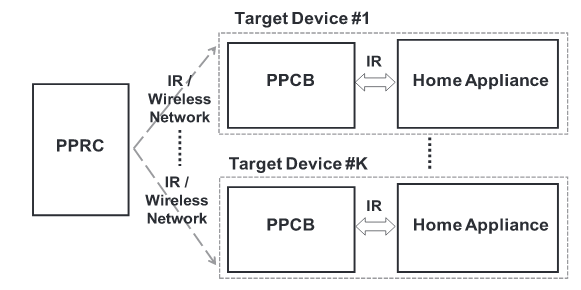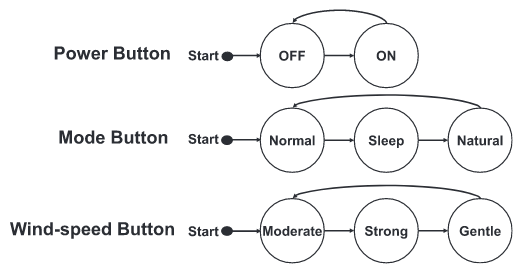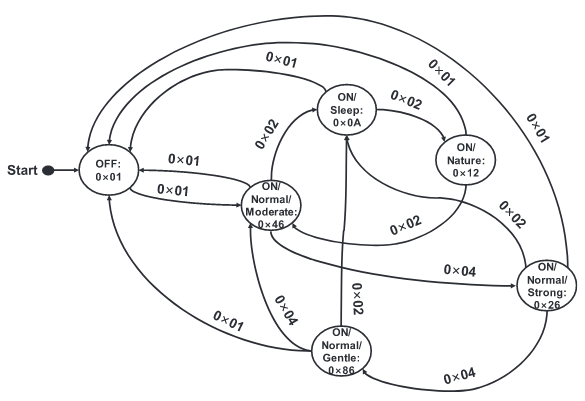ABSTRACT
With numerous connected devices and appliances, the smart home is one of the representative fields of Internet of Things (IoT). As the complexity of devices/appliances increase, numerous buttons (sometimes dozens) are designed on the remote controller in home spaces even if several of them are seldom used. A user maybe confused with the controller even if he or she only intends to perform a simple operation. This confusion also leads to a higher probability of maloperations. In addition, conventional methods of communication between remote controllers and connected devices, such as eXtensible Markup Language (XML) messages, are usually bandwidth-consumptive.
To address these problems, an intelligent universal remote control system for home appliances named Point-n-Press is proposed. Point-n-Press addresses the directionality feature, which enables easy and intuitive control by pointing to the target device to display the target’s control interface on the screen of the remote controller. By lever-aging the state dependencies of home device/appliance operations, only functional buttons that are relevant to the current context are utilized. Two real prototypes are implemented to verify the feasibility of the proposed scheme. The evaluation results show that Point-n-Press is a useful and suitable control scheme for IoT-based smart homes.
RELATED STUDIES

Fig.2. System architecture of the proposed control system
The architecture of Point-n-Press consists of two parts: 1) the Point-n-Press remote cont roller (PPRC) and 2) a number of target devices, which embed in the Point-n-Press control box (PPCB) for interacting with the PPRC, as shown in Fig.2.
PROPOSED SCHEME OF POINT-N-PRESS

Fig.6. Finite states of a fan’s control functions
Fig.6 illustrates an example of using a finite state diagram to represent the state transitions for controlling a fan with three buttons. By transforming the control flow of an appliance into a FSM, the UI only needs to show the states that are relevant to the current state (i.e.,candidates of subsequent states). Note that two state dependencies are included in the control process of this fan.

Fig.8. Transition state diagram of a fan’s operational states as represented in bit-string formats
As shown in Fig.8, once a user presses the “Power” button on the screen of the PPRC, the “0×01” control signal is transmitted and the current state becomes the “0×46” state (power on, normal mode, moderate wind speed). If the user presses the “Mode” button, the “0×02” control signal is transmitted and the current state becomes the “0×0A” state (power on, sleep mode, no display for wind speed operations).
SYSTEM IMPLEMENTATION
The second example of the demonstrated prototype is a lighting control system. As shown in Fig.9, the lighting control system is located in a smart home demo room, in which eight controllable lights and four control scenarios can be set. The designed control scenarios in the proposed lighting system include night, reading, cinema, and sleeping scenarios.
The system architecture of the proposed lighting control system is shown in Fig.10. The communications between the PPRC and the PPCB are IR, Bluetooth, and Wi-Fi. In addition, IR transmission is applied between the PPCB and the control gateway. Note that the control gateway is equipped with 2.3GHz,2Gbytes SDRAM, two USB connectors, and one USBIR receiver. The internal data transformation between the control gateway and the power line controller uses an USB cable.The plugs from no.1 to no.8 are connected to a power line controller via a power line network.
The operational UIs for controlling a fan are shown in Fig.11. A smart phone, which is treat ed as the PPRC, is picked up, and the “Be Ready” signal is sent to the PPCB, as shown in Fig.11(a). No other control icons are displayed on the screen of the PPRC at this time. Next, the PPRC receives the DCP from the PPCB via a Bluetooth or Wi-Fi wireless network after the PPRC is pointed to the PPCB of the fan.
The icon and the current state of the fan are displayed on the control screen (at this point, only the “Power” icon is displayed, which indicates that the fan is powered off, and other operations of the fan are not allowed), as shown in Fig.11(b). As the “Power” button is pressed, the state displayed on the screen of the PPRC is switched to power on. The fan is operated in normal mode with a moderate wind speed, as shown in Fig.11(c). After the “Mode” button is pressed, the fan is operated in natural mode without wind speed control functions (i.e., the “Speed” icon and related options are hidden), as shown in Fig.11(d).
CONCLUSION
An intuitive control system with a set of user-friendly operations, called Point-n-Press, is proposed for controlling connected devices/appliances in IoT-based smart homes. The proposed scheme leverages the directionality characteristic of IR to enable easy and intuitive control of devices (i.e.,controlling an appliance in smart homes by pointing to it). A user-friendly UI is designed by considering the state dependencies between each control operation. This design disables buttons that are irrelevant to the current context to prevent users from performing maloperations.
With the demonstration of two real prototypes with controlling appliances in smart homes, the feasibility of an intelligent universal remote control system for home appliances with intuitive and user-friendly features is verified. In the designs of the FSM and bit-string formatted control codes, the communication between remote controllers and appliances requires less bandwidth consumption. Compared with previous studies that employ conventional XML and the RF4CE-based approaches, the proposed control system significantly reduces the bandwidth consumption while multiple users simultaneously control numerous appliances.
Consequently, the proposed Point-n-Press control system not only enhances the features of intuition and user-friendliness but also establishes a less bandwidth-consumptive control system. Nevertheless, the implementation of the proposed control system is currently limited to IR sensors. Moreover, state dependencies of devices/appliances must be manually identified. Therefore, to control devices/appliances with a more precise pointing mechanism, and to support an auto discovery mechanism of state dependencies are two possible directions for future research.
Source: wineyard university
Authors: Kuen Min Lee | Wei Guang Teng | Ting Wei Hou
>> 200+ IoT Led Projects for Final Year Students
>> More Wireless Bluetooth Projects for Final Year Students
>> More Wireless Embedded Projects for Engineering Students
>> More Wireless Hacking Projects for Wi-fi Enthusiasts for Engineering Students


